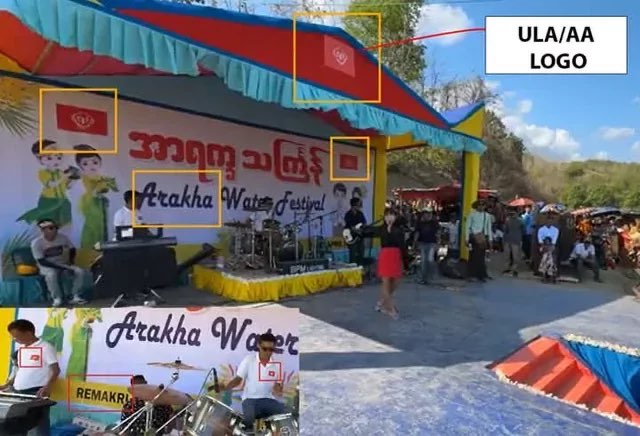The Arakan Army (AA), an ethno-nationalist rebel force, has seized control over approximately 90% of Myanmar’s Arakan State, including key towns and the entire border area with Bangladesh. This dramatic territorial gain places the AA at the center of complex geopolitical realignments involving regional powers India and China, both of whom have major investments in the region and seek to protect their interests amid the weakening power of Myanmar’s military junta.
Meanwhile, the AA’s harsh military campaign has intensified persecution of the Rohingya minority marked by violent assaults and drone attacks on civilian villages forcing increasing numbers of Rohingya to flee into already overcrowded camps in Bangladesh.
Arakan Army’s Rise: Control and Influence
Since its formation in 2009, the AA has grown into one of Myanmar’s most powerful insurgent groups. It now controls most of Arakan State, holding sway over 14 of 17 townships, and administering local governance functions through its own parallel institutions, including judicial, health, and law enforcement services. This proto-state governance model has expanded the AA’s influence beyond military might, as it has begun inviting foreign investment to develop Arakan’s infrastructure.
However, the AA’s military expansion comes with grave consequences for the Rohingya population, who continue to suffer violent campaigns, including drone attacks reported as recently as August 2024, undermining the AA’s international standing and humanitarian reputation.
Threat to the Myanmar Junta
The Myanmar military junta, or State Administration Council (SAC), faces its most significant challenge yet from the AA’s territorial advance. Loss of control over strategic regions such as Arakan and the Western Regional Military Command in Ann Township signals a weakening grip.
The AA has even expanded offensives into ethnic Bamar-majority regions beyond Rakhine, targeting munitions factories vital for arms supplies—potentially enabling self-sufficiency in weapons. In response, the junta has labeled the AA a terrorist organization and launched intensified military operations, including airstrikes and a “four-cuts” strategy aimed at isolating the AA. In a tactical shift, the SAC has also allied with some Rohingya armed groups against the AA, complicating the conflict’s ethnic dimensions.
Bangladesh’s Strategic Dilemma
Bangladesh, hosting over a million Rohingya refugees, views the AA’s control over the Myanmar side of the border as a geopolitical reality it cannot ignore. While Dhaka refuses to formally recognize the AA, informal engagement has become necessary to manage border security, bilateral trade, and humanitarian concerns.
Security incidents, such as AA abductions and shootings of Bangladeshi fishermen, as well as cross-border incursions including cultural events staged by AA members inside Bangladesh, have increased tensions. The AA is also suspected of involvement in drug trafficking, further troubling Dhaka.

Apparent Examples of ULA/AA Symbols in Bangladesh water Festival event
Moreover, Dhaka faces internal challenges as some Rohingya refugees in camps are reportedly recruited by militant groups aligned with the AA, raising fears of radicalization and complicating Bangladesh’s security landscape.
Regional Powers: China and India’s Calculus
China and India have substantial stakes in Arakan State, including major infrastructure projects such as China’s Kyaukphyu Deep Sea Port (a key component of the Belt and Road Initiative) and India’s Kaladan Multi-Modal Transport Project in Sittwe. Both strategic ports now lie within AA-controlled territory and have come under siege.
China has sought to protect its investments through a pact with the Myanmar junta to establish joint private security forces, while also maintaining informal ties with the AA, which pledged to safeguard Chinese infrastructure.
India, initially skeptical of the AA, has shifted to more direct engagement, with lawmakers visiting Rakhine and discussing security cooperation, motivated by concerns over insurgencies in its northeastern states and the recent violence in Manipur.
These developments signal a delicate balancing act by China and India as they navigate Myanmar’s fractured political landscape and the rise of the AA.
Conclusion: A Shifting Strategic Landscape
The AA’s consolidation in Rakhine State is reshaping regional geopolitics. The junta’s traditional alliances with China and India are strained as both powers increasingly engage with the AA to protect their regional interests.
Isolated internationally, the Myanmar junta has turned to Russia for deeper military and economic cooperation, seeking drone technology and investment, though these efforts are unlikely to offset the AA’s territorial gains.
For the Rohingya people, this changing landscape spells continued hardship, as the AA’s control has coincided with intensified persecution and displacement. Bangladesh and neighboring countries face a complex dilemma—balancing national security, regional diplomacy, and the urgent humanitarian crisis affecting millions of Rohingya refugees.
Rohingya Vision News
More Stories
CRCS Monthly Situation Report September 2025
The Rohingya Crisis: Escalating Conflict, Humanitarian Breakdown, and Regional Protection Failures The Center for Rohingya Refugee Crisis Studies (CRCS) has...
Dr Younus and UN Chief Push for Rohingya Repatriation
During a joint visit to the Rohingya refugee camps in Cox’s Bazar, Bangladesh’s interim government leader, Dr. Yunus, and UN...
NUG’s Silence on Rohingya Deaths in Maungdaw
The Rohingya community has expressed growing frustration and concern over the National Unity Government's (NUG) continued silence regarding the tragic...
Escalating Atrocities Against Rohingya in Maungdaw
This report provides a detailed analysis of the ongoing atrocities against Rohingya civilians in western Myanmar, particularly in Maungdaw, Arakan...
UN Warns of Another Rohingya Genocide Amid Twin Threats
The UN High Commissioner for Human Rights, Voler Turk, sounded warnings concerning a grave threat to the civilian population, specifically...
Bangladesh Border Guards Accused of Assaulting and Repatriating Rohingya Refugees
In February of last year, Fortify Rights, a human rights organization, reported that more than 300 Rohingya refugees were allegedly...